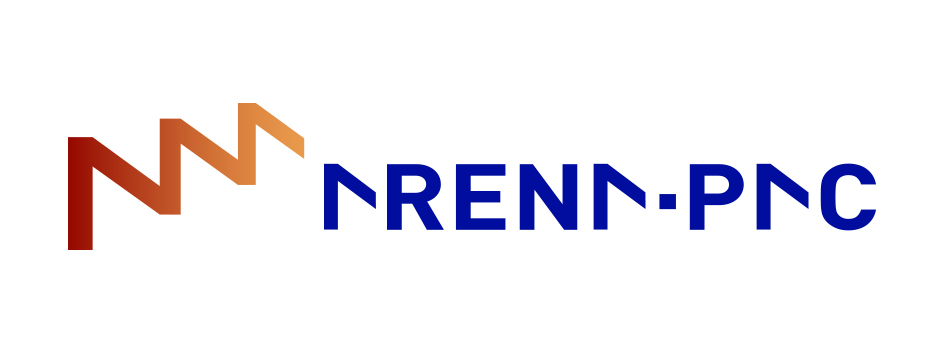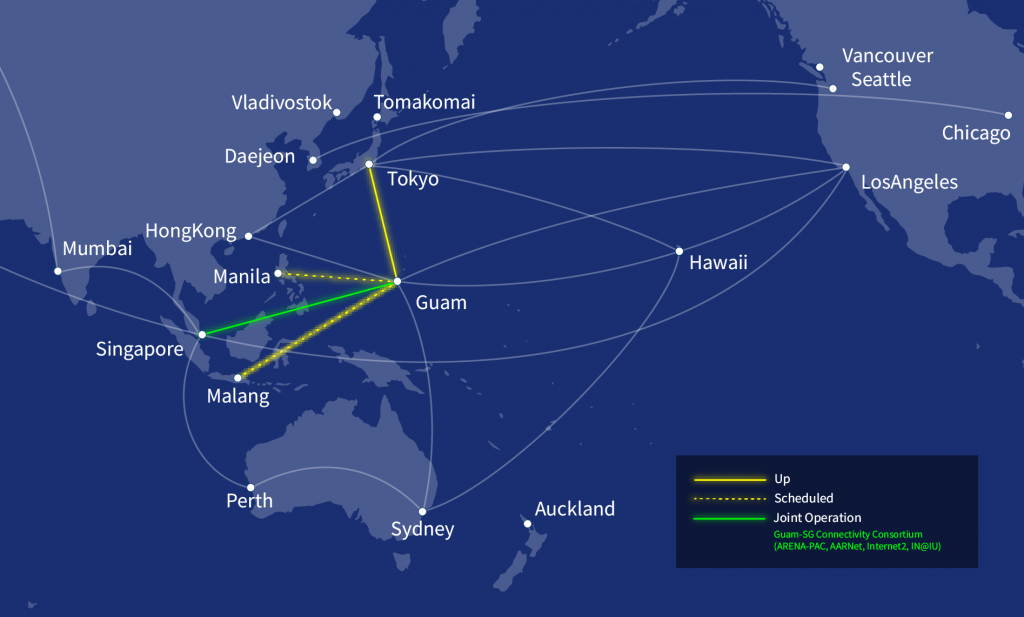*This report is excerpted from the WIDE Project Report 2021
*Click here for the PDF version of this report

Chapter 1. Introduction
This paper reports on the operation of ARENA-PAC (Arterial Research and Educational Network in Asia-Pacific), a broadband backbone network for research and education purposes in the Asia-Pacific region.
ARENA-PAC, which is operated by the WIDE Project, is a broadband backbone network for research and education purposes using a submarine cable network contracted for long-term use by the Asia Pacific Internet Development Trust (APIDT), a fund for the development of the Internet in the Asia Pacific region. In addition to the submarine cable network contracted for long-term use by APIDT, ARENA-PAC aims to become a wide-area high-capacity backbone network that can be called an “artery” extending across the Asia-Pacific region, as the name suggests, through interconnection with other research and education networks.
This paper reports on the current operational status, future expansion plans and international collaborative cooperation, including the 100 Gbps communication bandwidth line between Tokyo and Guam, which began operation in February 2021.
Chapter 2. Operational Status and Expansion Plans of ARENA-PAC
As of the end of January 2022, ARENA-PAC operates the following two lines.
- Tokyo-Guam 100 Gbps line
- Guam-Singapore 100 Gbps line (Guam-SG Connectivity Consortium: ARENA-PAC, AARNet, Internet2, joint lines by the IN@ IU Consortium)
In addition, preparations are underway to begin operation of the following two lines in 2022.
- Guam-Malang (Indonesia/IDREN)
- Guam-Quezon (Philippines/PREGINET)

Furthermore, in collaboration with the AI3/SOI-ASIA project, which has developed, operated, and
provided educational content streaming to the Asia-Pacific region using satellite communication
technology and Internet access technology during disasters, preparations are underway for
Internet access to the National University of Timor-Leste and to the REN via an overlay network.
Figure 1 summarizes the ARENA-PAC backbone network concept for these lines that are already in operation and future expansion plans. As shown in this figure, ARENA-PAC plans to build a broadband backbone network for research and education purposes in the Asia-Pacific region and to support international research and education activities through interconnection and collaboration with other research and education network operating organizations.
Below, we will be reporting on the Tokyo-Guam and Guam-Singapore lines that have begun operations.
2.1 Tokyo-Guam line opens and begins operation
On February 1, 2021, a 100 Gbps high-speed line between Tokyo and Guam was opened and began operation. At the same time, ARENA-PAC began operating AS (AS141682). On the Tokyo side, Juniper MX204 was installed in the WIDE Project NTT Otemachi NOC and is interconnected with WIDE Project (AS2500), SINET (AS2907) and GXP-Tokyo (APAN-JP, AS7660). On the Guam side, due to the tight global semiconductor supply and demand and travel restrictions, ARENA-PAC facilities (routers and switches) have not been installed in Guam, and with the cooperation of Guam Open Research and Education eXchange (GOREX), the Tokyo facility and GOREX (AS35889) are interconnected by directly accommodating the line using GOREX equipment (routers). In addition, routes to the University of Hawaii, UoG, AARNet, SingAREN, REANNZ and TransPAC are also exchanged through GOREX. With the opening and start of operation of the Tokyo-Guam line, the route from NAOJ’s Subaru Telescope to WIDE used to be via Hawaii-Seattle-Tokyo and the West Coast of the United States, with a Round Trip Time (RTT) of 171ms, but now the Hawaii-Guam-Tokyo route is available, with a significantly improved RTT of 96ms. For other cases and connecting organizations to better utilize the Guam-based network, it is necessary to optimize the routes so that sufficient bandwidth is available while minimizing delays through routing control techniques. Therefore, we plan on optimizing the routes from time to time in cooperation with connecting organizations.
2.2 Opening of the Guam-Singapore line and alternative route
As mentioned above, the Guam-Singapore line is a consortium joint line between four organizations, including ARENA-PAC, AARNet, Internet2 and IN@IU (Indiana University). The Guam and Singapore sides are accommodated by GOREX and SingaREN facilities, respectively. This line was scheduled to open in December 2021, but it was delayed due to submarine cable cutting and repair work, and the line was accepted and put into operation on January 20, 2022.
Since a part of JGN’s Tokyo-Singapore line was scheduled to be under construction from December 8, 2021, once this line was opened on December 6, 2021, ARENA-PAC’s Tokyo-Guam line and this line were set together as a backup route, which functioned normally as a backup as of December 8. However, this line was later disconnected on December 12. Subsequently, with the help of AARNet, an alternative Guam-Australia-Singapore route was established to maintain the Tokyo-Singapore connection over a shorter route than the route via the West Coast of the United State.
Chapter 3. Participation in APOnet
On June 17, 2021, ARENA-PAC agreed to establish and participate in the Asia Pacific Oceania network (APOnet), a cooperative framework for the development of high-speed networks in the Asia Pacific and Oceania region among the following 11 research and education network organizations
- Australia’s Academic and Research Network (AARNet)
- Arterial Research and Educational Network in Asia-Pacific (ARENA-PAC)
- University Corporation for Advanced Internet Development d/b/a (Internet2)
- Korea Institute of Science and Technology Information (KISTI)
- National Institute of Information and Communications Technology (NICT)
- National Institute of Informatics(NII)
- Pacific Wave International Exchange
- Research and Education Advanced Network New Zealand(REANNZ)
- Singapore Advanced Research and Education Network (SingAREN)
- TransPAC
- University of Hawaii (UH)
APOnet aims to support interdisciplinary research and education activities and scientific exploration and discovery through international collaboration through the exchange of experts and the shared use of operational data and scientific experimental facilities. For example, experimental data from high-resolution sensors and scientific experiment facilities, as well as ultra-high-resolution imaging and imaging instruments such as the global telescopes like the Event Horizon Telescope (EHT), are unprecedentedly large, and APOnet will support such international data transfer through inter-organizational cooperation.
As networks become increasingly important as the foundation for research and education activities, it is also important to provide adequate backup connectivity and bandwidth in the event of a network outage. Through inter-organizational cooperation, APOnet will also conduct operational activities to improve reliability and availability by sharing state-of-the-art technology, routing knowledge and operational data. The aforementioned mutual backup by the newly established Guam-Singapore route was also realized through this cooperation. As the operator of ARENA-PAC, the WIDE Project will continue to contribute to the realization of APOnet’s objectives and international research and education activities through technical knowledge sharing and network operation activities.
Chapter 4. Summary
This paper reported on the operation of ARENA-PAC, a broadband backbone for research and education purposes in the Asia-Pacific region. The WIDE Project will continue to contribute to the development of the international Internet through the operation of ARENA-PAC and collaboration with APOnet.
Excerpts from the WIDE Project Report 2021 